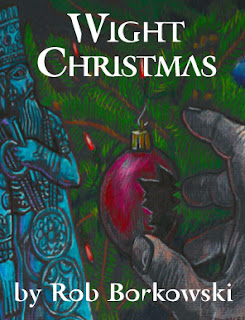His plan was to do this for about four or five short stories, then publish an omibus/anthology, but this was to be the first one. He also had a very small budget. (No pressure or anything)
Rob sent me the manuscript and I read it. It was short, easy read, only a page and a half long, and concerned a young man, who in the course of dismantling his roommate's Christmas decorations, runs afoul of an ancient Mesopotamian god named Marduk.
At first I assumed that the god's name and connection to Christmas was solely a product of Rob's fertile imagination, but in starting the research for the illustration, I discovered that the god Marduk and the associated festival of Zagmuk, has a long association with the Christmas and especially the Medieval concept of "misrule" where the established rules of the social order are reversed for a short period of time, kings become beggars, and beggars become kings.
Some writers trace elements of traditional European Christmas celebrations back to ancient Mesopotamian new year festivities. Indeed, an examination of the Zagmuk, or Akitu, festivals of ancient Mesopotamia reveals some striking resemblances to European celebrations of Twelfth Night and the Twelve Days of Christmas. There is more information about this connection here:
So this is where I started with the illustration. An ancient god, Christmas, and danger, all rolled into one. I decided to render the moment in the story when the main character reaches into a box of Christmas decorations, and cuts his finger on a broken Christmas ornament.
I needed to convey the sense of darkness and danger, but hint at the supernatural or occult nature of the story. I found a black and white rendering of the god Marduk.
I knew I was going to need some reference for the hand reaching for the ornament, so I took a picture of my own hand.
I also needed some reference for the Christmas decorations and tree branches.
Using those three sources I did a did a quick black and white sketch.
Not knowing the final dimensions for the cover, I did the sketch for the cover at a standard 8.5" x 11"size, assuming that a standard ratio would work at most sizes. This will become a slight problem later. I sent the sketch to Rob and he approved it. Now to do the final execution. During my research, I had come across an illustration of Egyptian idols done on black paper. I really liked the feel of the image.
Rob wanted the illustration to be in full color, but I thought I could adapt this style to a color illustration and still keep the somber quality of the original. I transferred the sketch to a piece of black linen paper, and started drawing with colored pencil. I really enjoyed working in a reverse method, adding in the highlights as opposed to adding in the shadows, is a great drawing exercise. I ended up with this:
It was reading a little darker than I wanted, so I brightened it up in Photoshop.
I layed out the book cover, selecting a typeface called Retrospecta. It seeemed to capture some of the other-wordly flavor of the story and still be readable. I sent the final artwork to Rob.
He loved it, but by this time had discovered that the thumbnail artwork that would appear on Amazon would only be 1 inch wide. The cover was a little hard to read at that size and worse, the artwork was too wide to fir in that size and still communicate the elements it needed to. So I had to go back into Photoshop and adjust the sizing of the image, eliminating the black borders, narrowing the artwork, and brightening it even further. Here is the final result. Still moody, but can still be read at the small size.











No comments:
Post a Comment